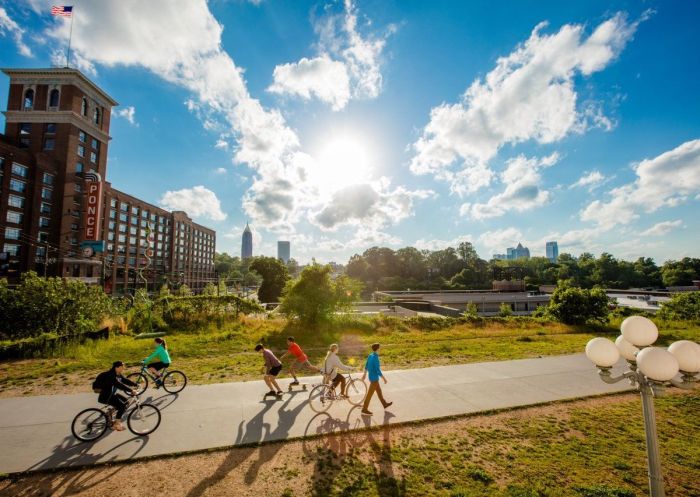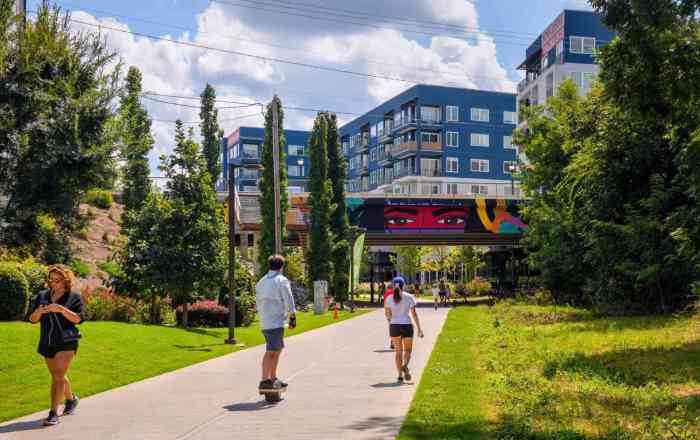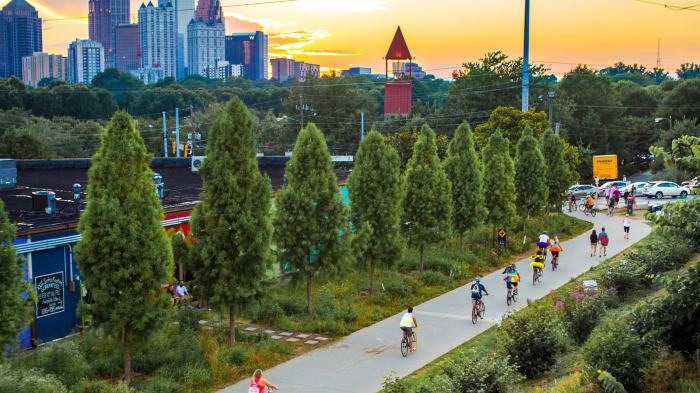The Atlanta BeltLine, a visionary project that has reshaped Atlanta’s urban landscape, is a captivating blend of economic development, environmental stewardship, and community revitalization. This transformative initiative has left an indelible mark on the city, fostering a thriving economy, enhancing environmental well-being, and promoting social equity.
With its innovative transportation network, the BeltLine has revolutionized connectivity, making it easier for residents and visitors to explore the city’s diverse neighborhoods and attractions. Its commitment to sustainability has resulted in improved air quality, reduced traffic congestion, and the creation of green spaces, contributing to a healthier and more vibrant urban environment.
Introduction
The Atlanta BeltLine is a transformative 22-mile loop of multi-use trails, parks, and transit that encircles the city of Atlanta, Georgia.
Conceived in the early 2000s, the BeltLine’s primary purpose is to reconnect Atlanta’s historic neighborhoods with its downtown core, fostering economic development, promoting healthy living, and preserving green space. Its construction utilizes the city’s abandoned railroad corridors, transforming them into vibrant public spaces that enhance the quality of life for Atlanta’s residents and visitors alike.
Economic Impact

The Atlanta BeltLine has had a significant economic impact on the city, spurring development, attracting businesses, and increasing property values.
The BeltLine has catalyzed the development of new businesses and industries along its path. For example, the Old Fourth Ward has seen a surge in new restaurants, breweries, and shops, while the Westside has become a hub for tech startups and innovation. The BeltLine has also attracted major corporations such as Google, Microsoft, and NCR to open offices in Atlanta.
Property Values
The BeltLine has also had a positive impact on property values. A study by Georgia State University found that properties within a half-mile of the BeltLine have increased in value by an average of 15% since its construction began. This has made homeownership more affordable for many Atlanta residents and has boosted the city’s tax base.
Explore the vibrant Atlanta BeltLine, a transformative urban trail that encircles the city, offering a unique perspective on its diverse neighborhoods and cultural landmarks. While you’re here, consider embarking on a cultural tour in Europe, immersing yourself in the rich history, art, and traditions of the continent.
From the cobblestone streets of Rome to the windmills of the Netherlands, cultural tours in Europe provide an unforgettable experience. Upon your return, continue your exploration of the Atlanta BeltLine, discovering hidden gems and connecting with the city’s vibrant community.
Job Creation
The BeltLine has also created jobs. The construction of the BeltLine has employed thousands of workers, and the new businesses and industries that have sprung up along its path have created even more jobs. The BeltLine is estimated to have created over 10,000 jobs in Atlanta.
Environmental Benefits

The BeltLine is not only a transportation and recreation project, but also an environmental initiative. It provides numerous benefits, including improved air quality, reduced traffic congestion, and increased green space.
The Atlanta BeltLine is a multi-use trail that circles the city of Atlanta, Georgia. It is a popular destination for hikers, bikers, and runners, and it offers stunning views of the city skyline. If you’re looking for a great hike in the US, be sure to check out the best hiking trails in the US.
The Atlanta BeltLine is a great option for a day hike or a weekend getaway.
One of the most significant environmental benefits of the BeltLine is its role in improving air quality. The BeltLine’s trails and parks absorb air pollution, reducing the amount of harmful pollutants in the air. The trees and other vegetation along the BeltLine also release oxygen, which helps to improve air quality and reduce greenhouse gases.
Reduced Traffic Congestion
The BeltLine also helps to reduce traffic congestion by providing an alternative mode of transportation. The BeltLine’s trails and bike paths allow people to walk, bike, or take public transportation instead of driving, which helps to reduce the number of cars on the road. This not only reduces air pollution, but also helps to improve traffic flow and reduce congestion.
Increased Green Space, Atlanta beltline
The BeltLine also increases the amount of green space in Atlanta. The BeltLine’s trails and parks provide a place for people to relax, recreate, and enjoy nature. The BeltLine also helps to connect different parts of the city, making it easier for people to access green space.
Mitigating Urban Heat Island Effects
The BeltLine also helps to mitigate urban heat island effects. Urban heat island effects occur when the temperature of a city is significantly higher than the temperature of the surrounding rural areas. This is due to the fact that cities have more buildings and pavement, which absorb and release heat. The BeltLine’s trees and other vegetation help to reduce urban heat island effects by providing shade and releasing moisture into the air.
Transportation and Connectivity

The BeltLine’s transportation network is a key component of its success. It connects different neighborhoods, promotes walking, biking, and public transit, and has a positive impact on traffic patterns and accessibility.
The BeltLine’s transportation network includes a 22-mile loop of multi-use trails, as well as several spur trails that connect to other neighborhoods and destinations. The trails are popular with walkers, runners, cyclists, and dog walkers, and they provide a safe and convenient way to get around the city. The BeltLine also has several transit stations, which make it easy to connect to other parts of the city by bus or train.
Impact on Traffic Patterns and Accessibility
The BeltLine has had a positive impact on traffic patterns and accessibility in Atlanta. The trails provide an alternative to driving, which has helped to reduce congestion on the city’s roads. The BeltLine has also made it easier to get around the city without a car, which has made it more accessible for people who live, work, or visit Atlanta.
Health and Wellness

The Atlanta BeltLine is not only a transportation and recreation corridor, but it also promotes health and wellness in various ways. It encourages physical activity, improves mental health, and fosters community engagement.
Physical activity is crucial for maintaining a healthy lifestyle, and the BeltLine provides ample opportunities for people to get moving. The 22-mile loop features dedicated bike lanes, walking paths, and green spaces, making it easy for residents to incorporate exercise into their daily routines. The BeltLine also hosts numerous fitness events and programs, such as group runs, bike rides, and yoga classes, further encouraging physical activity.
Mental Health
In addition to physical health, the BeltLine also has a positive impact on mental health. Spending time in green spaces has been shown to reduce stress, improve mood, and boost cognitive function. The BeltLine’s parks, trails, and gardens provide residents with tranquil oases where they can escape the hustle and bustle of city life and recharge.
Community Engagement
The BeltLine also fosters a sense of community engagement by connecting different neighborhoods and creating shared spaces. The shared use path encourages interaction between people from all walks of life, promoting social cohesion and a sense of belonging. Community gardens and public art installations along the BeltLine provide opportunities for people to come together, collaborate, and build relationships.
Arts and Culture

The Atlanta BeltLine is a vital hub for arts and culture in the city, providing a unique platform for artistic expression and fostering a thriving creative community.
The BeltLine offers ample space for public art installations, transforming the city’s landscape into an open-air gallery. Artists from all disciplines are invited to showcase their work along the trail, creating a vibrant and dynamic public art experience.
Festivals and Cultural Events
The BeltLine also hosts a diverse range of festivals and cultural events throughout the year. These events celebrate Atlanta’s rich cultural heritage, featuring live music, dance performances, art exhibitions, and community gatherings. The BeltLine’s central location and accessible trail system make it an ideal venue for these events, attracting visitors from all over the city.
Creative Economy
The BeltLine’s focus on arts and culture has had a significant impact on Atlanta’s creative economy. The presence of public art and cultural events has attracted artists, designers, and other creative professionals to the city, creating a vibrant and diverse arts community. This influx of talent has led to the growth of new businesses and industries related to the arts, contributing to the city’s economic vitality.
Community Development

The Atlanta BeltLine has been a catalyst for community development, revitalizing neighborhoods and fostering social equity. By creating a network of trails and parks, the BeltLine has improved access to green spaces, affordable housing, and transportation, leading to increased community engagement and economic growth.
Neighborhood Revitalization
The BeltLine has played a significant role in revitalizing neighborhoods along its path. By transforming abandoned industrial areas into vibrant public spaces, the BeltLine has attracted new residents, businesses, and investment. This has led to increased property values, improved infrastructure, and a renewed sense of community pride.
Affordable Housing
The BeltLine has also helped to address the need for affordable housing in Atlanta. The city has implemented policies to ensure that a portion of new housing units built along the BeltLine are designated as affordable, providing opportunities for low- and moderate-income residents to live in desirable neighborhoods.
Community Engagement
The BeltLine has fostered community engagement by creating opportunities for residents to participate in planning, design, and stewardship of the trail. Community organizations and residents have played a vital role in shaping the BeltLine’s development, ensuring that it meets the needs and aspirations of the community.
Future Plans and Vision

The Atlanta BeltLine is a transformative project that continues to evolve and expand. The future plans and vision for the BeltLine include several key initiatives that are expected to further enhance its impact on the city.
One of the major goals for the future is to complete the loop, connecting all eight segments of the BeltLine. This will create a continuous 22-mile trail that encircles the city, providing a vital transportation and recreational corridor for residents and visitors alike.
Transit and Connectivity
The BeltLine’s future plans also include expanding transit options along the corridor. This includes adding light rail and bus rapid transit lines, as well as improving pedestrian and bike infrastructure. These improvements will make the BeltLine even more accessible and convenient for commuters and travelers.
Economic Development
The BeltLine has already spurred significant economic development along its corridor, and this is expected to continue in the future. The city plans to invest in affordable housing, mixed-use developments, and commercial spaces, creating new jobs and opportunities for residents.
Exploring the Atlanta BeltLine, a transformative 22-mile loop of trails and parks, offers a unique blend of nature and urban life. If you seek luxurious accommodations to complement your BeltLine adventures, consider exploring luxury travel deals. Upon your return to the BeltLine, delve into its vibrant art scene, savor culinary delights, and embrace the city’s rich history as you traverse this remarkable urban oasis.
Environmental Sustainability
The BeltLine also plays a crucial role in promoting environmental sustainability. The trail provides a greenway that connects parks and green spaces, improving air and water quality and promoting biodiversity. Future plans include expanding these efforts, creating a more resilient and sustainable city.
Community Engagement
The Atlanta BeltLine is a community-driven project, and the future plans prioritize continued engagement with residents and stakeholders. The city plans to create opportunities for public input and feedback, ensuring that the BeltLine remains responsive to the needs of the community.
Challenges and Opportunities
As the Atlanta BeltLine continues to grow and expand, it will inevitably face challenges. These include funding, construction logistics, and the need to balance different interests and priorities. However, the city is committed to addressing these challenges and maximizing the opportunities that the BeltLine presents.
Concluding Remarks
As the Atlanta BeltLine continues to evolve, its future plans hold even greater promise for the city. With a focus on affordable housing, community engagement, and arts and culture, the BeltLine is poised to further enhance the lives of Atlantans and establish itself as a model for sustainable urban development.
Frequently Asked Questions: Atlanta Beltline
What is the Atlanta BeltLine?
The Atlanta BeltLine is a 22-mile loop of multi-use trails, parks, and transit that encircles the city of Atlanta, Georgia.
How long is the Atlanta BeltLine?
The Atlanta BeltLine is 22 miles long.
What is the purpose of the Atlanta BeltLine?
The Atlanta BeltLine is intended to connect people to jobs, recreation, and each other.